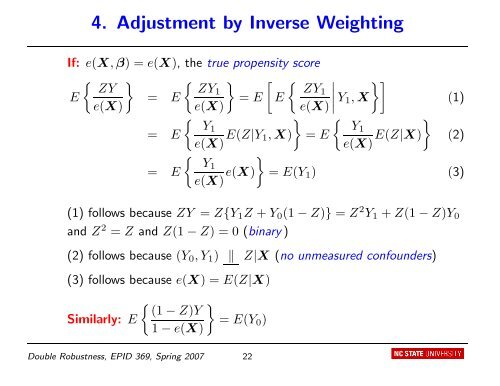Double Robustness in Estimation of Causal Treatment Effects
Double Robustness in Estimation of Causal Treatment Effects
Double Robustness in Estimation of Causal Treatment Effects
Create successful ePaper yourself
Turn your PDF publications into a flip-book with our unique Google optimized e-Paper software.
4. Adjustment by Inverse Weight<strong>in</strong>g<br />
If: e(X, β) = e(X), the true propensity score<br />
� �<br />
ZY<br />
E<br />
e(X)<br />
=<br />
� � � � �<br />
ZY1<br />
ZY1 �<br />
E = E E �<br />
e(X)<br />
e(X) � Y1,<br />
=<br />
��<br />
X<br />
�<br />
Y1<br />
E<br />
e(X)<br />
(1)<br />
E(Z|Y1,<br />
� �<br />
Y1<br />
X) = E<br />
e(X) E(Z|X)<br />
=<br />
�<br />
�<br />
Y1<br />
E<br />
e(X)<br />
(2)<br />
e(X)<br />
�<br />
= E(Y1) (3)<br />
(1) follows because ZY = Z{Y1Z + Y0(1 − Z)} = Z 2 Y1 + Z(1 − Z)Y0<br />
and Z 2 = Z and Z(1 − Z) = 0 (b<strong>in</strong>ary )<br />
(2) follows because (Y0, Y1) � Z|X (no unmeasured confounders)<br />
(3) follows because e(X) = E(Z|X)<br />
Similarly: E<br />
� �<br />
(1 − Z)Y<br />
1 − e(X)<br />
= E(Y0)<br />
<strong>Double</strong> <strong>Robustness</strong>, EPID 369, Spr<strong>in</strong>g 2007 22
















